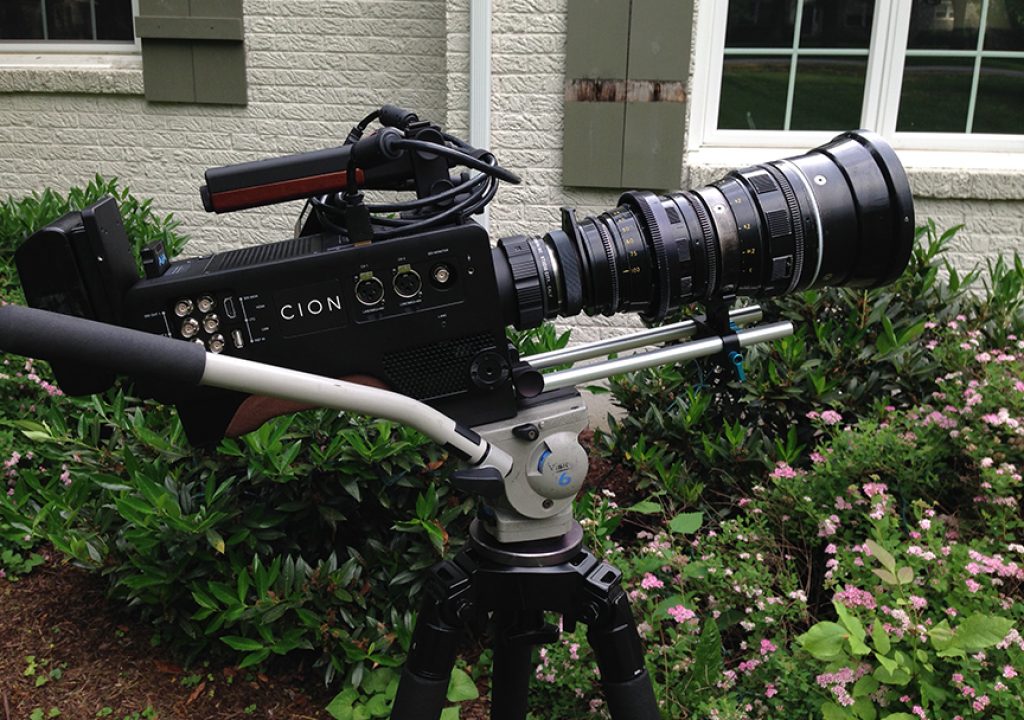Seven days was all the time I had with AJA’s Cion, and the results shuffled all my preconceived notions of the camera.
Seven days was all the time I had with AJA’s Cion, and the results shuffled all my preconceived notions of the camera.
AJA Cion “Backyard” Video Example from Brian Hallett on Vimeo.
From the moment it was announced, the AJA Cion was a camera conflicted. A budget camera, but with a PL lens mount. A middle market camera, with the need to buy expensive proprietary media. A system boosting elegant controls and a menu system that feels far less elegant.
Then the AJA Cion does so much right. Both a SDI and HDMI output for an EVF. A camera just as easy to use handheld as it is on a tripod without weighting too much. Beefing recording codecs like ProRes 444 with 12 bit color and true 4K resolution of 4096×2160 instead of UHD 3840×2160. Yet, we are in a 15 stop dynamic range world featuring higher, and higher ISOs. As you can understand, the AJA Cion became a camera without a market.
MAXIMIZE YOUR SHOOT, MINIMIZE YOUR POST became the marketing message. With the AJA Cion, you no longer needed 3D LUTs or long color correction sessions. The essence being, you see what you get. So I decided to try it. No post color correction for this 1080HD run & gun style shoot.
Dark skin tones under a gas station awning quickly shows a camera’s weakness. The Cion’s 12 stops of dynamic range shows for better or for worse and I think the Cion held its own. Run & gun shooting does this camera well. The electronic global shutter comes in handy during the whip pans and quick movement. The skin tone looks great to me for an uncontrolled shoot, and the color has potential. Next is another gas give-away shoot but on a brighter day.
AJA Cion Run & Gun Example #2 from Brian Hallett on Vimeo.
In this example, the highlights are blown out. The 12 stop dynamic range is not enough to pull the highlights and the lowlights into the scene together. The skin tone, when properly exposed, looks smooth and pleasing. I did have the time to pull the footage into DaVinci Resolve to pull more information into the whites, but there was little highlight detail to be found. The shadows had more leeway, more information, and I feel like I’d be comfortable to push the image if I had to.
There is something about an image requiring considerably less color correction. In the first video of this review, I was much more pleased. The 4K detail is great. The color and saturation has the potential to be stunning. It’d help considerably if the footage was shot at a more epic location instead of my backyard. Here is the youtube link to the 4K version of the video.
WHY A PL LENS MOUNT
AJA PAK MEDIA
AJA only recently has entered camera manufacturing. To them, they already had the knowledge to be able to make fast reliable media for a 4K camera. Unfortunately, their media is slightly more expensive then a CFast 2.0 card. 256GB AJA Pak Media is $695.00 and you’ll need to purchase one card reader at $395.00. Whereas Canon’s C300 Mark II uses Cfast 2.0 which cost around $586.95 for 256GB and the reader costs around $50. While the difference in price is nowhere near the likes of Red and their SSDs it is still something to consider if buying this camera. AJA Pak Media is robust and very reliable so you might consider the extra expense worth it in the end.
THE MENU
LIMITING ISOs
In 2006 ISO320 and 500 were acceptable. In this day and age they are restrictive. 800 or higher needs to be the native with the emphasis on higher. If you’re going to build a camera you want to sell often, clean image at higher ISOs are a must. Usually, us cameramen/women are working with smaller crews and smaller budgets. Help us get the shot in as many situations as possible and we will become loyal fans. One can pull up the shadow levels with the Cion quite a bit, but that’s digital film cameras. Do your tests and learn how far you can push it. I had the camera for seven days so I didn’t have time to do all the tests I’d like to usually do.
IS THIS CAMERA DEAD?
At the beginning of this article I wrote how I didn’t want to like this camera. In the end, I rather liked the image coming off the sensor. In a controlled shoot this camera has the potential to make some stunning images. I can see many indie filmmakers or commercial DPs using the camera. Plus, there is something about seeing what you’re getting off the sensor. If your images aren’t to your liking then change the lighting. The skin tones are great and the 4K detail is more than acceptable. AJA built an outwardly well designed camera with all the outputs needed, an easy to use hand-held camera, and a build suitable on larger sets. Now, if they can bring the rest of it all around they will have made a camera we all might be clammering to use.

